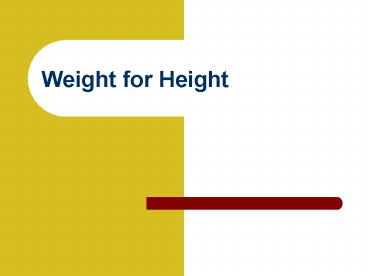Weight for Height - PowerPoint PPT Presentation
1 / 30
Title:
Weight for Height
Description:
Often questionnaire data on height and weight alone 'Ideal' and 'Desirable' Weight tables. Metropolitan Life Weight for Height Tables. Weight for Height Tables ... – PowerPoint PPT presentation
Number of Views:1170
Avg rating:3.0/5.0
Title: Weight for Height
1
Weight for Height
2
Desirable Body Weight
- Desirable, ideal, optimal
- What weight should I be?
- Weight for height
- Weight for height with frame size
- Weight with optimal body fat
- BMI - Body Mass Index
3
Weight for Height
- Epidemiologists needed a measure of obesity
- Often questionnaire data on height and weight
alone - Ideal and Desirable Weight tables
- Metropolitan Life Weight for Height Tables
4
Weight for Height Tables
Metropolitan Insurance Co., 1983, weights at ages
25-59 based on lowest mortality. Weight in
pounds according to frame (in indoor clothing
weighing 3 lbs., shoes with 1" heels).
5
Frame Size
Estimate of Skeletal Proportion
6
Weight for Optimal Body Fat
- If you know the current body fat, weight for
any optimal body fat can be calculated.
Consensus of an expert panel (1986). Arbitrary
cut-off points.
7
Calculation of optimal weight range
- 1. Calculate Fat Weight (FW)
- FW body weight x Ft
- Where Ft fractional expression of body fat
- 2. Calculate Fat-Free Weight (FFW)
- FFW Body Weight FW
- 3. Calculate the desired target weight (TW)
- TW FFW / (1 Fx)
- Where Fx fractional expression of body fat
8
Example Calculation Young Male Current weight
100kg, body fat 34
- 1. Calculate Fat Weight (FW)
- FW body weight x Ft
- FW 100 x .34 34kg
- 2. Calculate Fat-Free Weight (FFW)
- FFW Body Weight FW
- FFW 100 34 66kg
- 3. Calculate the desired target weight (TW)
- TW FFW / (1 Fx)
- _at_ 12 TW 66 / (1 - .12) 66 / 0.88 75kg
- _at_ 18 TW 66 / (1 - .18) 66 / 0.82 80.5kg
9
Weight range taking into account error in
determination of body fat
- 95 confidence estimates of body fat
- Fat ?(1.96 x S.E.E.)
- 34 ?(1.96 x 3.7) 26.7 to 41.3 body fat
- 95 confidence estimates of FFW are
- upper limt FFW 100 26.7 73.2kg
- lower limit FFW 100 41.3 58.7kg
- Lower limit for target weight at 12 body fat
- TW 58.7 / (1 - .12) 58.7 / 0.88 71.6kg
- Upper limit for target weight at 18 body fat
- TW 73.2 / (1 - .18) 73.2 / 0.82 83.2kg
10
Body Mass Index
- (Quetelet Index - 1833)
11
Adolphe Quetelet (1796-1874)
- After development is complete, the weight of
individuals of both sexes approximates the square
of the height - Quetelet Index
- Weight / Height2
12
Best Weight for Height Index as an indicator of
obesity
- High correlation with weight
- Low correlation with height
- Good correlation with fatness criterion
13
Human Architecture
- Tall people are more linear than short people
- Tall people tend to have proportionally longer
limbs - Males tend to have proportionally longer limbs
than females
14
Allometry
- Growth of one part in relation to the growth of
another part - Isometry - same proportions maintained during
growth (same shape)
15
Physical Dimensions
L Length T Time M Mass
16
VELOCITY DISTANCE / TIME L/T L
1T-1
17
(No Transcript)
18
Geometrical Similarity System
- with increase in size there is no change in shape
or body composition
19
Geometrical Similarity System
Length L1 Mass L3 Time L1
20
VELOCITY DISTANCE / TIME L1/L1
L1L-1 L0
21
(No Transcript)
22
Huxleys Allometric Curve
Y aXb
23
Huxleys Allometric Curve
Log10Y log10a blog10X
Curve is linearized by logging both
sides b-value is used to describe relative
growth
24
(No Transcript)
25
Canada Fitness Survey (1981) (20-29 years old)
26
Galileos Cube-Square Law
- If a structure increased in all dimensions
equally, it would grow weaker because if shape
and composition are constant, volume (and mass)
increase as the cube of the linear dimensions but
strength only increases as the square.
27
Olympic Weightlifting
- Weight predicting strength
- Theoretically under G.S.M. b 0.6777
- 1968 0.709
- 1972 0.681
- 1976 0.696
28
Kin 303 (96-3)
29
Ross et al. 1988
- Correlations of BMI good with sum of skinfold
corrected-girths and even bone widths
30
BMI
- BMI is not an indicator of body fat in
individuals it is a measure of weight for height - May be used in conjunction with other measures

